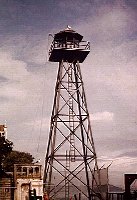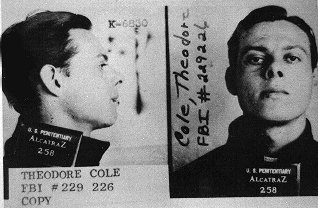 | Escapes from Alcatraz |  |
![]()
Note: Alcatraz was not escape-proof, at least not during the military period (1853-1933). The first escape, in 1878, was engineered by a pair of men who stole one of the post's boats and rowed themselves to shore. Other prisoners tried to get off using articles such as a butter vat, a bread-kneading trough, driftwood, logs, planks, a discarded ladder, and other bits of flotsam. Four prisoners secured their release by forging the commander's signature on some release papers which the Army duly processed. They were caught a few days after their "discharge". Two other men took advantage of the 1918 flu epidemic: they donned flu masks and officer uniforms for the boat ride to the Presidio. They, too, were caught several days after their release. Most escapees took an easier route: they waited to be assigned to a shore detail and simply walked off. The last recorded attempt by a military prisoner was that of Jack Allen. Allen greased his body and plunged into the bay in June, 1930. He, like Roe and Cole and many others was never seen again and became a myth of possibilities. |
![]()
| Date of Attempt | Names & Crimes | What Happened? |
| April 27, 1936 | Joseph Bowers Post Office Robbery |
Perhaps this wasn't the first escape attempt from the U.S. Penitentiary. A guard spied Bowers climbing over a fence and shot him. The question is what was Bowers doing? Prisoner accounts claim that Bowers was a "bug", a nutcase, who'd ended up in the prison for stealing $16.00 from a Marin County post office. Bowers worked down in the incinerator. He enjoyed feeding the sea gulls. Convict Henry Larry claims to have watched Bowers stack some empty barrels and climb up next to the fence so he could retrieve a bit of food which had fallen on the barbed wire. He stood there feeding the birds for several minutes until a tower guard turned, saw him atop the fence, and fired on the convict. Bowers fell seventy feet to his death. |
| December 16, 1937 | Theodore Cole Kidnapping Ralph Roe Armed Robbery |
Alvin Karpis watched as Cole and Roe broke through two panes of glass in the mat shop, sawed through a metal sash, and popped through the resulting opening. Cole then twisted off a padlock and rushed out to the water's edge. The pair negotiated their way through a perimeter of rubber tires and submerged barbed wire. Karpis reported that the current then picked them up and carried them off in the direction of the Golden Gate. A low fog prevented him from seeing their fate. Prison authorities mounted a massive search when the two didn't turn up for the 1:30 pm count. Prisoners clung to the hope that they'd made it. For years, newspapers reported sightings of the pair. And prisoners believed that Warden Johnston received annual postcards from South America signed "Ted and Ralph". Exceptionally high and fast tides on the day of the break, however, made their survival improbable. Authorities declared them dead. |
| May 23, 1938 | Whitney Franklin Bank Robbery Thomas Limmerick Armed Robbery & Kidnapping James "Tex" Lucas Bank Robbery |
This threesome left their jobs in the woodworking shop carrying a hammer, lead weights, and some pieces of iron. On the third floor of the industrial building they used the hammer to bash in the back of guard Royal Cline's skull. They slipped through a window and made their way to the roof. The tower guard spotted them and shot Limmerick and Franklin. The trio quickly surrendered. Limmerick died that night. Cline died the next day, leaving a wife and four small daughters. |
| January 13, 1939 | Arthur "Doc" Barker Kidnapping William Martin Post-Office Robbery Rufus McCain Bank Robbery Dale Stamphill Kidnapping Henry Young Bank Robbery |
Barker was shot through head and legs. Others captured. The story of this escape and its repercussions can be found in Tales from Colma. |
| May 21, 1941 | Floyd H. Barkdoll Bank Robbery Joseph Paul Cretzer Bank Robbery & Murder Arnold T. Kyle Bank Robbery, Assault & Murder Sam R. Shockley Robbery & Kidnapping |
Brothers-in-law Joseph Paul Cretzer and Arnold T. Kyle led this precursor to the 1946 blast-out. Cretzer and Kyle had arranged for Cretzer's wife to show with a speed boat. After capturing the mat shop foreman, the four participants took an emery wheel to the shop's steel bars. Other officials, including the Superintendent of Industries, a captain, and a guard lieutenant interrupted their work briefly and were rewarded with capture. The emery wheel did little and the boat never showed. The gang gave up after Captain Madigan convinced them that they could not get out. They later learned that Mrs. Cretzer had been picked up by San Francisco vice officers that same morning. Cretzer and Shockley were later implicated in the 1946 Blast-Out. |
| September 1941 | John R. Bayless Bank Robbery |
John Bayless kept to himself. One day when a fog drifted unexpectedly over the island, he saw his chance and sneaked to the water. The bay proved too cold for him and he foundered. Guards pulled him from the drink before hypothermia set in. A few months later, when Bayless was taken to the city to stand trial for his escape attempt, he tried to bolt from the courtroom. For his two attempts, he received an additional five year sentence. |
| April 14, 1943 | James Boarman Bank Robbery Harold Brest Bank Robbery Floyd Hamilton Bank Robbery Fred Hunter Kidnapping & Harboring Fugitive |
The mat shop hosted this hostage affair. The four cons grabbed a guard and Captain Weinhold as they made their rounds. They kicked out pre-cut bars in the mat shop, pushed a plank over the gap between the industrial building and the perimeter fence, and climbed over it to the water's edge. As they entered the water, Captain Weinhold worked his gag loose and whistled for help. The tower guard spotted the escapees and open fired immediately. Brest was wounded and Boarman killed. A few hours later, searchers found Hunter in a tidal cave. Warden Johnston announced that Hamilton had also been slain (despite the lack of a body). Hamilton turned up several days later, having hid in same tidal cave where guards had found Hunter. |
| August 1943 | Ted Walters Bank Robbery |
Walters got himself assigned to work Saturdays in the laundry when the tower guards paid less attention to the island's industrial sector. He slipped from the laundry, climbed a fence, and fell onto his back, injuring his spine. He made his way to the water anyways, but could get nowhere with the injury. Guards fished him out and sent him to solitary. |
| July 1945 | John K. Giles Assault on a Postman |
Giles, a dock worker responsible for handling the war-time shipments of dirty Army uniforms to and from the Rock, collected several pieces of a Technical Sargeant uniform, dressed himself in it, and almost got to shore aboard the Army launch before his absence was noticed. Giles came closer to succeeding than any other prisoner during the U.S. Penitentiary period. |
| May 2, 1946 | Clarence Carnes Kidnapping Bernard Paul Coy Bank Robbery Joseph Paul Cretzer Bank Robbery & Murder Marvin Hubbard Kidnapping, Auto Theft, Firearms Theft Sam Shockley Robbery & Kidnapping Miran Thompson Robbery & Kidnapping |
The bloodiest incident in Alcatraz's history pitted a detachment of combat savvy Marines and the Bureau of Prisons against three men armed with seventy-two rounds of ammunition and two guns. Two guards were killed, one (R.J. Miller) when Cretzer attempted to slay several captives and another (Harold Stites) when he stepped into the crossfire. The lives of D-Block inmates were jeopardized by intensive shelling. Coy, Hubbard, and Cretzer were finally cornered in a utility passage and either slain or driven to suicide. Writing on the wall of the cell where captured guards were kept pointed the finger at the men named here. Carnes alone was spared both informal and formal execution. |
| July 23, 1956 | Floyd P. Wilson Murder |
Wilson disappeared from the dock. For twelve hours, he evaded prison guards. |
| September 29, 1958 | Aaron Burgett Post Office Robbery Clyde Johnson Bank Robbery |
The pair were working on garbage detail when they surprised their guard and tied him up. Jumping into the water, Johnson made it as far as the rock known as "Little Alcatraz" before he gave up and waited for the guards to fetch him. Burgett disappeared. Two weeks later, his body was found floating near the Rock, making his the only missing bodyto be recovered in the Penitentiary's history. |
| June 11, 1962 | Clarence Anglin Bank Robbery John W. Anglin Bank Robbery Frank Lee Morris Bank Burglary Alan (Clayton) West Trans. Stolen Vehicle |
The attempt which inspired the Clint Eastwood film Escape from Alcatraz. The participants fashioned plaster heads with real hair swept up from the barber shop floor. On the night they chose to leave, they left these heads in their beds and crept through the ventilators in their cells in the utility corridor. West could not fit through his hole and remained behind. From here, they wormed their way up to the roof. Prison authorities discovered that the men carved the holes with spoons stolen from the kitchen and an electric drill fashioned from a fan. There was also the usual question of whether these men made it to shore. The only trace ever found of them was a crudely-fashioned wallet filled with cash. Prisoners and romanticists continued to hope that Morris and the Anglins had made it. |
| December 12, 1962 | John Paul Scott Bank Robbery Daryl Parker Bank Robbery |
Scott and Parker plunged in the water three months and one week before the prison closed. Parker blew his wind and swam to Little Alcatraz to avoid drowning. Scott, a better swimmer, paddled all the way to Fort Point using water wings he'd fashioned from a pair of rubber gloves. Once on the mainland, he collapsed from exhaustion and hypothermia. Two boys spotted him and called for help. Soon Scott was back on the Rock, his one bit of glory being that he was the only man to have made it off the Rock all the way to shore. This was the last escape from Alcatraz. |
